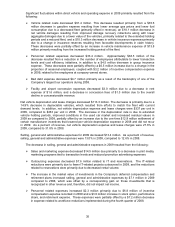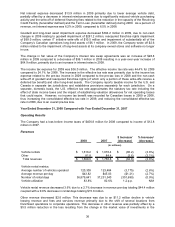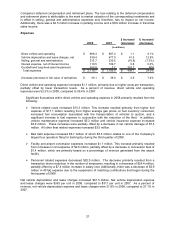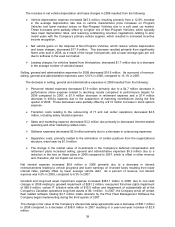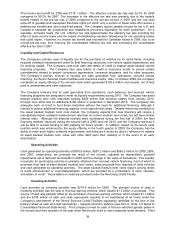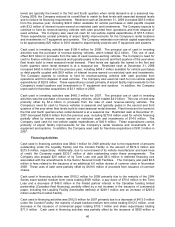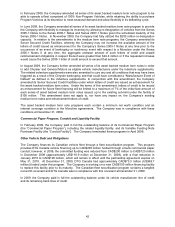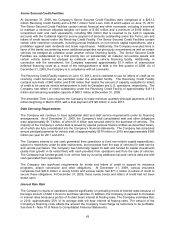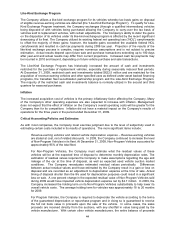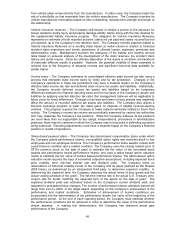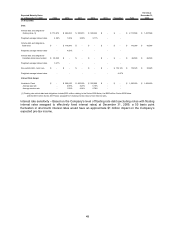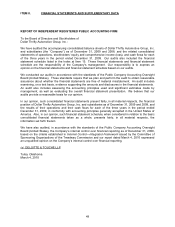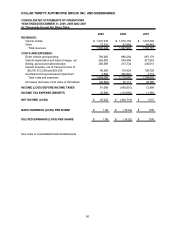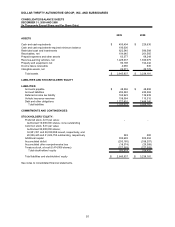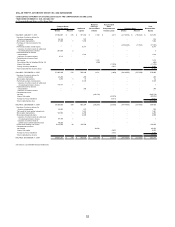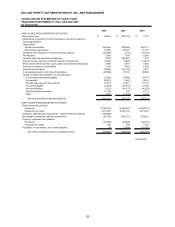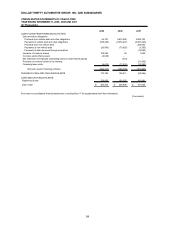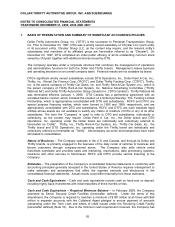Thrifty Car Rental 2009 Annual Report Download - page 46
Download and view the complete annual report
Please find page 46 of the 2009 Thrifty Car Rental annual report below. You can navigate through the pages in the report by either clicking on the pages listed below, or by using the keyword search tool below to find specific information within the annual report.from vehicle sales comes directly from the manufacturer. In either case, the Company bears the
risk of collectibility on that receivable from the vehicle manufacturer. The Company monitors its
vehicle manufacturer receivables based on time outstanding, manufacturer strength and length of
the relationship.
Vehicle insurance reserves – The Company self-insures or retains a portion of the exposure for
losses related to bodily injury and property damage liability claims along with the risk retained for
the supplemental liability insurance program. The obligation for Vehicle Insurance Reserves
represents an estimate of both reported accident claims not yet paid and claims incurred but not
yet reported, up to the Company’s risk retention level. The Company records expense related to
Vehicle Insurance Reserves on a monthly basis based on rental volume in relation to historical
accident claim experience and trends, projections of ultimate losses, expenses, premiums and
administrative costs. Management monitors the adequacy of the liability and monthly accrual
rates based on actuarial analysis of the development of the claim reserves, the accident claim
history and rental volume. Since the ultimate disposition of the claims is uncertain, the likelihood
of materially different results is possible. However, the potential volatility of these estimates is
reduced due to the frequency of actuarial reviews and significant historical data available for
similar claims.
Income taxes – The Company estimates its consolidated effective state income tax rate using a
process that estimates state income taxes by entity and by tax jurisdiction. Changes in the
Company’s operations in these tax jurisdictions may have a material impact on the Company’s
effective state income tax rate and deferred state income tax assets and liabilities. Additionally,
the Company records deferred income tax assets and liabilities based on the temporary
differences between the financial reporting basis and the tax basis of the Company’s assets and
liabilities by applying enacted statutory tax rates that management believes will be applicable to
future years for these differences. Changes in tax laws and rates in future periods may materially
affect the amount of recorded deferred tax assets and liabilities. The Company also utilizes a
like-kind exchange program to defer tax basis gains on disposal of eligible revenue-earning
vehicles. This program requires the Company to make material estimates related to future fleet
activity. The Company’s income tax returns are periodically examined by various tax authorities
who may challenge the Company’s tax positions. While the Company believes its tax positions
are more likely than not supportable by tax rulings, interpretations, precedents or administrative
practices, there may be instances in which the Company may not succeed in defending a position
being examined. Resulting adjustments could have a material impact on the Company’s financial
position or results of operations.
Share-based payment plans – The Company has share-based compensation plans under which
the Company grants performance shares, non-qualified option rights and restricted stock to key
employees and non-employee directors. The Company’s performance share awards contain both
a performance condition and a market condition. The Company uses the closing market price of
DTG’s common stock on the date of grant to estimate the fair value of the nonvested stock
awards and performance based performance shares, and uses a lattice-based option valuation
model to estimate the fair value of market based performance shares. The lattice-based option
valuation model requires the input of somewhat subjective assumptions, including expected stock
price volatility, term, risk-free interest rate and dividend yield. The Company relies on
observations of historical volatility trends of the Company and its peers (defined as the Russell
2000 Index), as determined by an independent third-party, to determine expected volatility. In
determining the expected term, the Company observes the actual terms of prior grants and the
actual vesting schedule of the grant. The risk-free interest rate is the actual U.S. Treasury zero-
coupon rate for bonds matching the expected term of the award on the date of grant. The
expected dividend yield was estimated based on the Company’s current dividend yield, and
adjusted for anticipated future changes. The number of performance shares ultimately earned will
range from zero to 200% of the target award, depending on the Company’s achievement of the
performance and market conditions. Estimates of achievement of market conditions are
incorporated into the determination of the performance shares’ fair value at the beginning of the
performance period. At the end of each reporting period, the Company must estimate whether
the performance conditions will be achieved in order to determine the value of the performance
shares awarded. In making this determination, the Company has observed actual past
performance of the Company.
45


